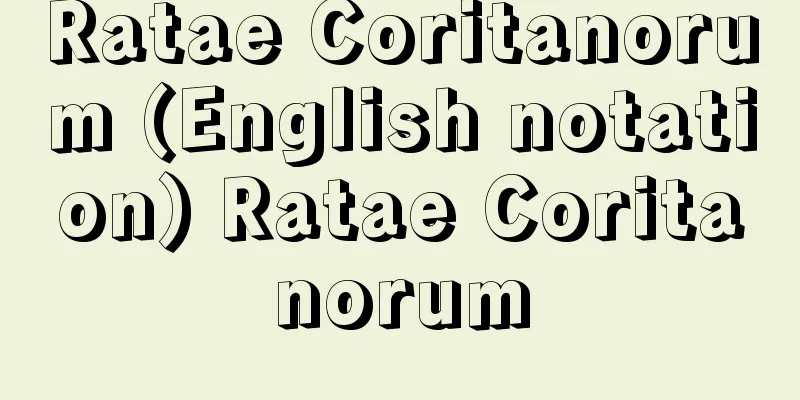Feudal system

|
A historical concept that indicates the system of land ownership and peasant control by samurai, or feudal lords, from the late Heian to the Sengoku period. In this case, lord refers to the feudal ruling class in feudal society, separate from the term used in historical documents. In the Middle Ages, ruling classes included manorial lords such as powerful aristocrats, large temples and shrines, and powerful samurai families under the manor and public land system, as well as local lords, but the concept of feudal lordship sees the role of local lords, or samurai, as the driving force behind the formation of medieval feudal society. Ishimoda Sho, who constructed the theory of feudal lordship, viewed the change from ancient times to the Middle Ages as a process in which the development of the feudal lordship system overcame the manor system, which had a slave-like social structure, and considered the local feudal system to be the first stage of the development of the feudal lordship system. The second stage was a regional feudal system in which local lords were organized by region, and he positioned the shugo daimyo as the ones who established the pure feudal lordship system. After that, the development from the original feudal lordship system based on the agricultural promotion function to a feudal lordship system in which distribution function was inevitable was discussed, and it was the kokujin lords under the control of the shugo daimyo that were positioned as the developmental stage of the feudal lordship system, and the power of the Sengoku daimyo was defined as the highest historical stage of the development of the local lordship system. Through these revisions, the theory of the feudal lordship system was organized as the developmental stages of the local lordship system, from the jito lord system to the kokujin lord system, and then the Sengoku daimyo domain system. On the other hand, there are arguments that view medieval society as a whole as a structural and static one, with manor lords and local lords as a whole being a feudal lord class, and that the framework in which the lordship's control extended to the peasants is described as constitutive control. In addition, issues have been raised about the structure in which "small lords = village lords" were reproduced throughout the transitional period from the Middle Ages to the Early Modern Period, and the nature of the local lordship system mediated by villages. [Tetsuo Suzuki] "Research on the History of Rural Areas in the Middle Ages of Japan" by Kyohei Oyama (1978, Iwanami Shoten) " "Thinking about the History of the Middle Ages" by Susumu Ishii (1991, Azekura Shobo) Source: Shogakukan Encyclopedia Nipponica About Encyclopedia Nipponica Information | Legend |
|
平安後期から戦国時代にかけての武士すなわち領主による土地所有や百姓支配の体制を示す歴史学上の概念。この場合の領主は、史料上の用語とは別に封建制社会における封建的な支配身分を意味している。中世の支配身分には、荘園公領(しょうえんこりょう)制下での権門(けんもん)貴族、大寺社、武家権門などの荘園領主層と在地領主層があったが、領主制概念は在地領主すなわち武士に中世の封建制社会形成の担い手としての役割を見出す概念である。 領主制論を構築した石母田正(いしもだしょう)は、古代から中世への変革を領主制の発展が奴隷制的な社会構成の荘園制を克服していく過程ととらえ、在地領主制を領主制発展の第一段階ととした。第二段階は在地領主を地域的に編成した地域的封建制であり、守護大名こそが純粋な封建領主制を確立したと位置づけた。その後は、勧農機能を基礎とする本来的な領主制から流通機能を不可避とする領主制への発展が論じられるとともに、守護大名の支配下にあった国人(こくじん)領主こそが領主制の発展段階に位置づけられること、そして戦国大名権力こそが在地領主制発展の最高の歴史段階と規定された。こうした修正によって、領主制論は在地領主制の発展段階として、地頭領主制から国人領主制、そして戦国大名領国制へと整理された。他方、荘園領主と在地領主は総体として封建的領主階級であると中世社会全体を構造的・静態的にとらえる考え方や領主制支配が百姓に及ぶ枠組みを構成的支配と説明する議論がある。また、中・近世移行期を通じて「小さな領主=村落領主」が再生産される構造や村落を媒介にした在地領主制のあり方が課題とされている。 [鈴木哲雄] 『大山喬平著『日本中世農村史の研究』(1978・岩波書店)』▽『石井進著『中世史を考える』(1991・校倉書房)』 出典 小学館 日本大百科全書(ニッポニカ)日本大百科全書(ニッポニカ)について 情報 | 凡例 |
Recommend
Sweet Orange
A fruit drink sold by Glico Dairy Co., Ltd. Source...
Labor Liberation Organization (English: Osvobozhdenie truda)
The first Marxist group in Russia. It was founded ...
Tiger
...Ethiopia is home to 70-80 languages belongin...
Vegetable market - Seikashijo
Also known as a vegetable market, this is a wholes...
Ogino Kengyo
Born: February 1731, Aki [Died] June 22, 1801 (Kyo...
Aggregard - Aggregard
...Between the plantation owners and the slaves w...
Osue no ma
...The name of men and women who served the Imper...
Hainan New Journal
...A daily newspaper published in Kochi before Wo...
Mitosis
…This reduction in the number of chromosomes by h...
Sea Cobra - Uminokobura
…They are often confused with the fish-like sea s...
Chelyuskin, SI (English spelling)
…An Arctic Ocean meteorological and hydrological ...
Umlaut
…But the plural ending /i/ in the final position ...
African political systems
...After the research of PG Vinogradov, E. Durkhe...
Fashoda incident
In 1898, British and French forces clashed in Fas...
Kaminari - Thunder
The title of a Kyogen piece. Demon Kyogen. In the...









